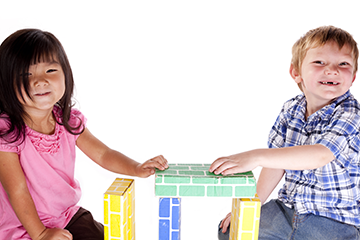What strategies can teachers use to support these children?
Page 9: Promote Peer Support and Interaction
 Although peers spend a lot of time together, they are often overlooked as a resource for supporting the learning and language needs of young ELs with disabilities. However, if peers are to play such a role, teachers must first structure social opportunities and teach peers communication strategies. It is important for teachers to be intentional and explicit when using peer-communication strategies. Below are three practices teachers can use to promote peer support and interactions.
Although peers spend a lot of time together, they are often overlooked as a resource for supporting the learning and language needs of young ELs with disabilities. However, if peers are to play such a role, teachers must first structure social opportunities and teach peers communication strategies. It is important for teachers to be intentional and explicit when using peer-communication strategies. Below are three practices teachers can use to promote peer support and interactions.
- Create opportunities that encourage young ELs to interact with their English-speaking peers. In the context of these activities, all the children are able to practice goals, including learning new words and concepts. For example, the educator can be intentional about how they:
- Assign a group of children that includes ELs as well as English speakers to play together in a center
- Pair an EL child with an English-speaking child for a playground activity
- Create a small-group art project during which young ELs and their English-speaking peers are required to share materials
- Create and support opportunities that encourage children to communicate with a peer who shares the same home language. For example, the educator can:
- Arrange for two young ELs to look at a book together and discuss what they see
- Seat two young children with the same home language next to each other at the snack table
- Arrange for a few children who speak the same language to be in a small group together
- Systematically teach English speakers to effectively communicate with their EL peers. By doing so, teachers can increase the likelihood that the interactions are successful and rewarding for all. Teachers can systematically teach English-speaking peers to:
- Initiate interaction by making eye contact, asking him or her to play, or offering a toy or material (e.g., “Come play with us!”)
- Speak slowly and clearly
- Persist in initiating the interaction, if the peer does not respond
- Request clarification from the EL peer if the response was not understood (e.g., “Regina, will you tell me again?”)
- Repeat and restate when the EL peer does not seem to understand what you said (e.g., “Regina, can you hand me the doll’s hair clip?” Restated: “Give me the hair clip” [shows similar item])
- Teach English-speaking children key words and phrases in many different languages as a way to help them to learn a new language and to support their EL peers
Rosa Milagros Santos talks about some benefits of using English-speaking peers to help support young ELs (time: 0:51).
Rosa Milagros Santos, PhD
Professor, Special Education
University of Illinois at Urbana-Champaign

Transcript: Rosa Milagros Santos, PhD
Just as it’s important that children are able to speak with their peers who speak the same language, it’s equally important that they also have access to peers who speak English, because that’s usually the language in schools. They need to have good models for using the language. Who better to give that to them than their peers because they provide all those natural contexts and natural interactions that the children can then begin to learn how to use words, phrases. In many ways, young children are less threatening when you’re trying out new words and new language. They’re less likely to judge you. They’re more likely to be forgiving and be more encouraging of young children who are just trying to say new words or phrases. They may correct them but not in a mean way.
A look inside Mrs. Raymond's classroom
During outdoor play, Mrs. Raymond facilitates a game with a group of children who all speak Burmese. She allows the children to play the game using their home language. Because she does not speak Burmese, she tries not to unnecessarily interrupt the children’s game by asking questions in English or redirecting them to use English. Instead, Mrs. Raymond allows their play to unfold naturally.